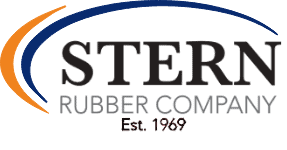Here at Stern Rubber, we do 3 main types of molding: compression, transfer and injection. Over the next 3 blogs, I will describe each of them in detail, and will start with compression molding.
Compression molding is the most simple of the three, as you load rubber into the cavity, close the tool, squeeze out the extra, and let it cure. It is good for low to medium volume parts.
These types of molds are made from steel or aluminum. The shape of the part is cut into the mold. The tool is run into a hydraulic press that has heated platens. The rubber has to be held at high pressure and high temperature. The platens can be heated by electric heating elements or hot oil or steam. Stern Rubber uses all electrically heated platens. Parts are normally cured at a 300 to 350 degrees Fahrenheit.
The tool is heated through simple contact with the platens of the press. The rubber is loaded in the cavity of the mold, and the tool is closed. Any extra rubber is squeezed out of the cavity. The presses run at high pressure, with clamp pressures from 10 to 1000 tons.
The tool is held closed for 5 to 15 minutes depending on the thickness of the part. When the cure time is complete, the tool is opened and the part is removed.
The advantages include lower cost tooling, and it is good for small production runs. It also does not use gates, sprues, or runners, which consume extra material, and can detract from the cosmetic requirements. It is also a good way to produce large parts that take a significant amount of material to manufacture.
Some of the disadvantages include slower process times, and greater waste of material, as this type of molding requires the cavity to be over-filled to ensure there is enough material to wash out any possible trapped air. It also difficult to control the amount and thickness of flash, or the extra rubber that overflows out of the cavity. This also means that the parts have more variation in thickness, so the parts normally need to allow for more dimensional tolerance.
If you have want to learn more about this process, or think you have a project that will be a good fit for compression molding, please contact us at sales@sternrubber.com.
